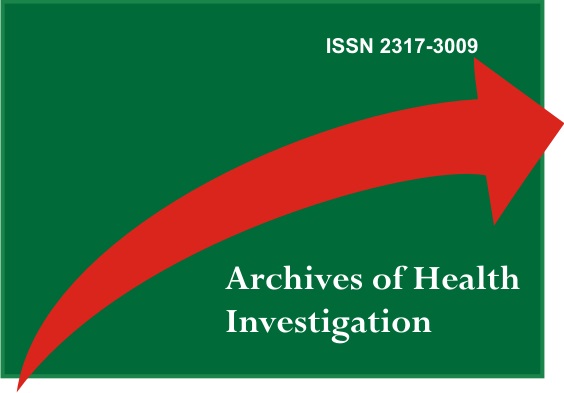Minimum invasive aesthetic solution: use of professional whitening in dental office to soften molar-incisive hypomineralization
DOI:
https://doi.org/10.21270/archi.v10i9.5265Keywords:
Tooth Desmineralization, Tooth Bleaching Agents, Tooth Bleaching; Permanent dental restoration; Hydrogen peroxideAbstract
Objective: To report the case of a patient with molar-incisor hypomineralization (MIH) on the incisors treated with dental professional whitening using the artifice of protecting the hypomineralized lesion to avoid painful symptoms and mask the lesions.Case Report: A 22-year-old patient, in good general health, sought dental care with a major complaint related to esthetics in the anterior region. On clinical examination, MIH was observed, with mild severity. In the upper and lower incisors, there were white/creamy demarcated opacities in the incisal third of the vestibular surfaces without posteruptive enamel breakdown. In molars, there were satisfactory atypical restorations in composite resin. The patient reported no sensitivity. To mask the hypomineralized regions, it was proposed the use of dental bleaching in the office with 35% carbamide peroxide. As an adjunct strategy, a photopolymerizable gingival barrier was used to block the contact of the bleaching agent with the hypomineralized regions. This strategy aimed to avoid painful sensibility and reduce the contrast between enamel defects and healthy enamel. There was no sensitivity during the procedure. At the end of the treatment, the tooth was observed with a uniform chroma, a noticeable improvement in aesthetics and patient satisfaction. Conclusion: Dental professional whitening with coverage of MIH defects proved to be a suitable option to mask hypomineralized regions.
Downloads
References
Weerheijm KL. Molar incisor hypomineralization (MIH): clinical presentation, aetiology and management. Dent Update. 2004;31(1):9-12.
Elfrink MEC, Schuller AA, Weerheijm KL, Veerkamp JSJ. Hypomineralized second primary molars: prevalence data in Dutch 5-year-olds. Caries Res. 2008;42:282–5.
Schwendicke F, Elhennawy K, Reda S, Bekes K, Manton DJ, Krois J. Global burden of molar incisor hypomineralization.J Dent. 2018;68:10-8.
Costa-Silva CM, Jeremias F, de Souza JF, Cordeiro RCL, Santos-Pinto L, Zuanon ACC. Molar incisor hypomineralization: prevalence, severity and clinical consequences in Brazilian children. Int J Paediatr Dent. 2010;20(6):426-34.
Tourino LF, Corrêa-Faria P, Ferreira RC, Bendo CB, Zarzar PM, Vale MP. Association between molar incisor hypomineralization in schoolchildren and both prenatal and postnatal factors: A population-based study. PLoS One. 2016;11(6):e0156332.
de Lima MD, Andrade MJ, Dantas-Neta NB, Andrade NS, Teixeira RJ, de Moura MS, et al. Epidemiologic study of molar-incisor hypomineralization in schoolchildren in North-Eastern Brazil. Pediatr Dent. 2015;37(7):513-9.
Silva MJ, Scurrah KJ, Craig JM, Manton DJ, Kilpatrick N. Etiology of molar incisor hypomineralization - A systematic review. Community Dent Oral Epidemiol. 2016;44(4):342-53.
Hubbard MJ, Mangum JE, Perez VA, Nervo GJ, Hall RK. Molar Hypomineralisation: A Call to Arms for Enamel Researchers. Front Physiol. 2017;8:546.
Elhennawy K, Manton DJ, Crombie F, Zaslansky P, Radlanski RJ, Jost-Brinkmann PG, et al. Structural, mechanical and chemical evaluation of molar-incisor hypomineralization-affected enamel: A systematic review. Arch Oral Biol. 2017;83:272-81.
Costa FS, Silveira ER, Pinto GS, Nascimento GG, Thomson WM, Demarco FF. Developmental defects of enamel and dental caries in the primary dentition: A systematic review and meta-analysis. J Dent. 2017;60:1-7.
Americano GCA, Jacobsen PE, Soviero VM, Haubek D. A systematic review on the association between molar incisor hypomineralization and dental caries Int J Paediatr Dent. 2017;27(1):11-21.
Almuallem Z, Busuttil-Naudi A. Molar incisor hypomineralization (MIH) – an overview. Paediatr Dent. 2018;225(7):601-9.
Steffen R, Krämer N, Bekes K. The Würzburg MIH concept: the MIH treatment need index (MIH TNI): A new index to assess and plan treatment in patients with molar incisior hypomineralisation (MIH). Eur Arch Paediatr Dent. 2017;18(5):355-61.
Lygidakis NA, Wong F, Jalevik B, Vierrou AM, Alaluusua S, Espelid I. Best Clinical Practice Guidance for clinicians dealing with children presenting with Molar Incisor Hypomineralisation (MIH): An EAPD Policy Document. Eur Arch Paediatr Dent. 2010;11:75-81.
Ghanim A, Silva MJ, Elfrink MEC, Lygidakis NA, Mariño RJ, Weerheijm KL, et al. Molar incisor hypomineralisation (MIH) training manual for clinical field surveys and practice. Eur Arch Paediatr Dent. 2017;18(4):225-42.
Mast P, Rodriguez MT, Daeniker L, Krejci I. Understanding MIH: definition, epidemiology, differential diagnosis and new treatment guidelines. Eur J Paediatr Dent. 2013;14(3):204-8.
Fragelli CMB, Souza JF, Jeremias F, Cordeiro RCL, Santos-Pinto L. Molar incisor hypomineralization (MIH): conservative treatment management to restore affected teeth. Braz Oral Res. 2015;29:S1806-83242015000100271.
Crombie F, Manton D, Palamara J, Reynolds E. Resin infiltration of developmentally hypomineralised enamel. Int J Paediatr Dent. 2014;24:51-5.
Doméjean S, Ducamp R, Léger S, Holmgren C. Resin infiltration of non-cavitated caries lesions: a systematic review. Med Princ Pract 2015;24(3):216-21.
Kumar H, Palamara JEA, Burrow MF, Manton DJ. An investigation into the effect of a resin infiltrant on the micromechanical properties of hypomineralised enamel. Int J Paediatr Dent. 2017;27:399-411.


